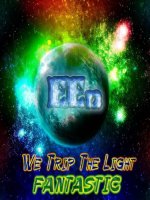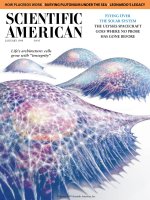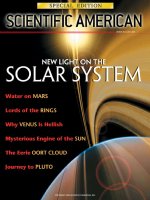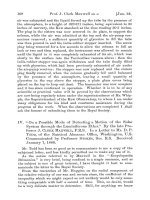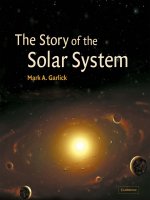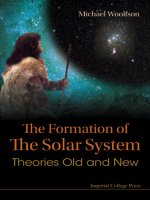- Trang chủ >>
- Khoa Học Tự Nhiên >>
- Vật lý
5 7 the solar system (earth sciences)
Bạn đang xem bản rút gọn của tài liệu. Xem và tải ngay bản đầy đủ của tài liệu tại đây (5.07 MB, 12 trang )
Earth Sciences
Standards
Preview
5.b. Students know the solar system
includes the planet Earth, the Moon,
the Sun, eight other planets and their
satellites, and smaller objects, such as
asteroids and comets.
Standard Set 5. Earth Sciences
5. The solar system consists of planets
and other bodies that orbit the Sun
in predictable paths. As a basis for
understanding this concept:
5.c. Students know the path of a
planet around the Sun is due to the
gravitational attraction between the
Sun and the planet.
5.a. Students know the Sun, an average
star, is the central and largest body
in the solar system and is composed
primarily of hydrogen and helium.
by Martin E. Lee
Genre
Nonfiction
Comprehension Skill
Make Inferences
Text Features
•
•
•
•
Captions
Diagrams
Tables
Glossary
Science Content
Solar System
Scott Foresman Science 5.7
ISBN 0-328-23471-0
ì<(sk$m)=cdehbe< +^-Ä-U-Ä-U
Vocabulary
asteroid
comet
ellipse
planet
satellite
solar system
star
by Martin E. Lee
Picture Credits
Every effort has been made to secure permission and provide appropriate credit for photographic material.
The publisher deeply regrets any omission and pledges to correct errors called to its attention in subsequent editions.
Unless otherwise acknowledged, all photographs are the copyright © of Dorling Kindersley, a division of Pearson.
10 ©USGS/Photo Researchers, Inc.; 11 JPL/NASA; 12 Getty Images; 16 NASA; 17 JPL/NASA; 19 ©Mark Garlick/Photo
Researchers, Inc.
ISBN: 0-328-23471-0
Copyright © Pearson Education, Inc. All Rights Reserved. Printed in the United States of America.
This publication is protected by Copyright, and permission should be obtained from the publisher prior to any
prohibited reproduction, storage in a retrieval system, or transmission in any form by any means, electronic,
mechanical, photocopying, recording, or likewise. For information regarding permission(s), write to
Permissions Department, Scott Foresman, 1900 East Lake Avenue, Glenview, Illinois 60025.
1 2 3 4 5 6 7 8 9 10 V010 13 12 11 10 09 08 07 06
What is the Sun?
The Star of Our Solar System
A star is a huge ball of very hot gas that gives off
energy. Our Sun is a star. It is the center of the solar system.
The solar system is the Sun and its planets. It also
includes many moons, asteroids, and comets.
The Sun is the largest object in our solar system. It has
almost 99 percent of all the mass in our solar system. The
Sun also has about one million times the volume of Earth.
The Sun’s size is average for a star. Stars called giants
can be 8 to 100 times larger in diameter than the Sun.
Supergiants can be more than 500 times larger than the
Sun. Other smaller stars are only around the size of Earth.
The Sun gives off lots of energy. The temperature in
the Sun’s center is very high. The hydrogen particles move
quickly because of this. When these particles hit each other,
they can combine into helium. The fusion of hydrogen into
helium makes most of the Sun’s energy.
The Explosive Sun
The Sun is like a ball of hot gases. The Sun has no hard
surfaces, but it does have layers. The photosphere is the part
of the Sun that gives off the light energy we can see. The
layer above that is called the chromosphere. The corona is
the outermost layer of the Sun.
If you looked at the Sun through scientific instruments,
you would see a lot of activity. Galileo saw dark spots
moving along the face of the Sun. We now call these dark
spots sunspots. They look dark because they are cooler than
the rest of the photosphere.
The number of sunspots does not stay the same. The
number changes in cycles of about 11 years. Sometimes there
are many sunspots, at other times there are few.
Sunspots may be the size
of Earth or larger.
The Sun is the central
and largest body in our
solar system.
2
3
Solar Eruptions
Hot gases may leap out of the
chromosphere. They can shoot far into the
corona. These glowing ribbons of gas are
called prominences. Prominences may
appear and then disappear over a few
days or months.
Other explosive things happen
in the chromosphere. Parts of the
chromosphere sometimes erupt like
a volcano. This is called a solar flare.
A solar flare looks like a bright spot
in the chromosphere. It may last
for minutes or hours. A solar flare
sends out energy into space that
can affect electronics on Earth. The
energy can disturb radio signals
and damage electrical systems.
Prominences rise with great
speed and power. Some
may get as high as one
million kilometers.
Solar flares give off
more light than other
parts of the Sun. They
also give off more
X-rays and other
kinds of energy.
4
5
Why do planets
revolve around
the Sun?
The Solar System
Our solar system includes the Sun, the planets, their
moons, and other objects. Every object in the solar system
moves around the Sun. Their path of movement is called an
orbit. The planets’ orbits are shaped like ellipses. An ellipse
is a shape like an oval.
Remember that our Sun is a star. A planet is a large,
round object that moves around a star. Planets are cooler
and smaller than stars are. Some planets seem to shine, but
they don’t give off their own light. A planet shines because
it reflects the light given off from its star.
Gravity keeps planets in their orbits. Gravity is a force
of attraction between objects. The Sun and the planets
are attracted to each other by gravity. The force of gravity
between the Sun and a planet is strong enough to move the
mass of the planet. But it is not strong enough to move the
Sun. Planets do not move in straight lines. Gravity makes
them move in an ellipse around the Sun.
The picture below shows the eight known planets of the
solar system. The four planets nearest to the Sun are called
the inner planets. The four planets farthest from the Sun
are the outer planets. Asteroids and comets also revolve
around the Sun.
Uranus
Jupiter
Mercury
Venus
Earth
Saturn
Neptune
Mars
Asteroid belt
6
7
Gravity and the Moon
Free Falling
The Moon is a satellite of Earth. A satellite is an object
that orbits another object in space. Most planets in the solar
system have at least one moon. Mercury and Venus do not.
Our Moon moves in an elliptical orbit around Earth.
The force of gravity keeps the Moon in its orbit. The Moon’s
mass is much less than that of Earth. So gravity between
the Moon and Earth keeps the Moon orbiting Earth.
Why doesn’t gravity make the Moon crash into Earth?
The reason is that the Moon is always moving forward.
At the same time, the gravity of Earth is always pulling
inward. This balance keeps the Moon in a steady orbit.
Astronauts in space look weightless. But they are really
falling in space. This effect is called free fall.
Gravity on Earth pulls objects toward Earth’s center.
Gravity makes a thrown ball follow a curved path. The ball
moves forward, but it also curves as gravity pulls it down.
A ball thrown hard enough would go all the way around
Earth. This is what happens when a spaceship orbits Earth.
The spaceship falls all the way around Earth in an orbit. It
is moving forward and downward at the same time.
Suppose you are going down a hill in a roller coaster.
It feels like you could float out of your seat. This is because
you and the roller coaster are falling at the same rate. The
same thing happens in a spaceship orbiting Earth. The ship
and the astronauts fall together in their orbit. Gravity pulls
on them both, but the astronauts can’t feel the effect. The
astronauts feel weightless inside the spaceship.
Orbiting the Sun
The Moon orbits Earth while both the Moon and Earth
orbit the Sun. This is the same with other planets and their
moons too. Gravity between a planet and its moons holds
its moons in orbit. And gravity keeps planet-moon systems
in orbit around the Sun.
Astronauts are weightless because
they are in free fall.
Gravity keeps the Moon in
orbit around Earth.
8
9
What are the inner
planets?
Mercury
Mercury is the planet nearest to the Sun. It is a bit
bigger than the Moon. Mercury has thousands of low spots
called craters on its surface. They were made long ago when
meteorites crashed into Mercury. A meteorite is a rock from
space that has hit the surface of a planet or a moon.
Scientists sent a space probe called Mariner 10 to
Mercury in 1973. It arrived at Mercury in 1974. A space
probe is a vehicle that studies objects in space using
cameras and other tools.
Mercury’s average
surface temperature
is 117°C (243°F).
10
Too Hot and Too Cold
Mercury is blazing hot during the day. This is because
it is so near the Sun. Its daytime temperatures are over
five times higher than anywhere on Earth. But Mercury
has almost no atmosphere. Without atmosphere, the heat
escapes. This makes Mercury very cold at night.
Venus
Venus is the second planet from the Sun. It is about the
same size as Earth. Venus is very hot and dry, like Mercury.
But Venus has an atmosphere of thick clouds. These clouds
are burning hot and poisonous! There are strong
winds and lightning. The clouds reflect
the Sun’s light very well. This makes
Venus one of the brightest objects
you can see in the night sky on
Earth.
11
Earth
Mars
Earth is the third planet from the Sun. It is the solar
system’s largest rocky planet. It is the only planet with
liquid water on its surface.
Earth’s atmosphere is about 150 kilometers thick. This
thick layer of gas makes life possible on Earth. It contains
nitrogen, oxygen, carbon dioxide, water vapor, and other
gases. Earth’s plants and animals need these gases. The
atmosphere filters out some of the Sun’s harmful rays. So
far, scientists think Earth is the only planet in the solar
system that can support life.
Mars is the fourth planet from the Sun. Its soil has a
reddish-brown material in it called iron oxide. It makes up
rust. Mars has two moons. Both of them have many craters.
Mars has an atmosphere. But the atmosphere doesn’t
have enough oxygen for plants or animals to live. Winds
on Mars cause dust storms that can cover the whole planet!
Mars has ice caps at its poles. These ice caps grow in
the winter and shrink in the summer. Mars has many
volcanoes. It also has a canyon that is almost ten times
longer than Arizona’s Grand Canyon.
The Viking I probe landed on Mars in 1976. The
Sojourner robot explored part of Mars in 1997. In 2004,
two robot rovers landed there. They were named Spirit and
Opportunity. They gathered data and sent it back to Earth.
Scientists hope that the data will tell them more about the
rocks and soil there. They also want to find out if
Mars has or once had water.
The Moon
Moons are satellites of planets. Moons revolve around
planets in the same way that planets revolve around the
Sun. Both happen because of gravity. And gravity between
a planet and its moons keeps the moons in their orbits.
Earth has one large moon. It is about one-fourth the size
of Earth. The Moon has almost no atmosphere. It has many
craters from when meteorites crashed into its surface.
This is one of the
Mars rovers that
landed in 2004.
Earth’s average
surface temperature
is 15°C (59°F).
12
13
Asteroids
Comets
An asteroid is a rocky object up to several hundred
kilometers wide that revolves around the Sun. Sometimes
asteroids are called minor planets. Most asteroids are found
in the asteroid belt. This area is between Mars and Jupiter.
Most asteroids take three to six Earth years to orbit the Sun.
Asteroids have uneven shapes. Some have smaller asteroids
that orbit them. The smallest asteroids are like pebbles.
Asteroids have hit Earth. You can still see some of the
craters that formed. But don’t worry; it happens very rarely.
Jupiter’s gravity keeps most asteroids within the space
beyond Mars.
A comet is a frozen mass of different kinds of ice and
dust. A comet orbits around the Sun. Comets are much
smaller than planets. Many of them come from parts of
the solar system past Pluto. They travel through the solar
system in very elliptical paths. Every year, several comets
may enter our solar system and orbit the Sun. But you are
unlikely to see them. You need a telescope to see all but the
largest comets.
Two Tails A comet’s two
tails may be up to 80
million kilometers long!
Coma A giant cloud of
dust and gases surrounds
the nucleus. This is called
the coma.
Asteroid Eros In 2001,
Eros became the first
asteroid to be landed upon
by a spacecraft. Eros is 33
kilometers long and 13
kilometers thick.
14
Nucleus The nucleus of
a comet may be just a
few kilometers wide.
15
What do we know
about the outer
planets and beyond?
Jupiter
Jupiter is the fifth planet from the Sun. It is the largest
planet in our solar system. It is a gas giant. A gas giant is a
very large planet made up mostly of gases. Hydrogen and
helium make up most of Jupiter’s atmosphere. In 1610,
Galileo used his telescope to see Jupiter’s four largest moons.
The diameter of Jupiter
is 142,984 kilometers
(88,846 miles).
Saturn
The sixth planet from the Sun is also a gas giant.
Saturn’s atmosphere is mostly hydrogen and helium. Saturn
is very large but not as dense as the other planets.
Saturn is orbited by bright rings. The Voyager space
probe found that the rings are made of bits of ice, dust,
and rock. The bits range in size from tiny grains to large
boulders.
Uranus
Uranus was discovered in 1781 by William Herschel.
It is the seventh planet from the Sun. Uranus is the most
distant planet you can see without a telescope. Uranus is a
gas giant. Its atmosphere is made up of hydrogen, helium,
and methane. Uranus is cold enough to make methane
condense into a liquid. Drops of liquid methane cover
Uranus in a cloud. They give it a fuzzy blue-green color.
Like other gas giants, Uranus has rings and many
moons. The rings were first seen by a space probe in 1977.
Uranus rotates on its side. Scientists think that
something large may have hit Uranus when the solar
system was forming. This hit may have
knocked the planet onto its side.
Besides rings, Saturn has
at least thirty-four moons.
16
17
Neptune
Pluto
Neptune is the eighth planet from the Sun. It is the
smallest of the gas giants. You need a telescope to see
Neptune. Neptune has a long orbit because it is very far
from the Sun. It takes over one hundred Earth years for
Neptune to travel around the Sun.
Neptune’s atmosphere is like that of Uranus. Methane
in its atmosphere gives it a bluish color. Neptune also has
bands of clouds and storms like Jupiter has. Neptune had
one huge storm named the Great Dark Spot. The Voyager 2
probe saw it in 1989. Five years later, the storm was gone.
Neptune was discovered in 1846. Its largest moon,
Triton, was seen just days later. Triton may be the coldest
body in the solar system. It has a surface temperature of
about -235°C. Neptune has at least thirteen moons.
In 1930, Clyde Tombaugh found a small, rocky object
in space. Sometimes it orbits beyond Neptune. This object is
called Pluto.
Pluto is about the same size as Earth’s moon. It has a
moon called Charon that is just a little smaller than Pluto.
Pluto has at least two other moons. They are called Nix
and Hydra.
In 2006, scientists decided to call Pluto a dwarf planet.
A dwarf planet is a small, round or ball-shaped object that
revolves around the Sun.
Other Dwarf Planets
In 2005, scientists found a dwarf planet that is a little
larger than Pluto. The dwarf planet is at least three times
farther from the Sun than Pluto. It has at least one moon.
This dwarf planet is called Eris.
There is also a dwarf planet
called Ceres in the
asteroid belt.
Neptune, like Uranus, has rings.
Neptune‘s ring
system
18
Charon is very close to
Pluto.
19
Glossary
asteroid
a rocky object up to several hundred
kilometers wide that revolves around
the Sun
What did you learn?
1. What objects in space make up the solar system?
2. In what two ways are planets different from stars?
3. Name the planets in order, from nearest to farthest from the Sun.
comet
a frozen mass of ice and dust with a tail
up to 80 million kilometers long that is in
orbit around the Sun
4.
Suppose your friend worries that gravity
will make the Moon crash into Earth. Write a letter persuading
your friend to stop worrying. State your position. Support it with
facts and data.
dwarf planet
a small, ball-shaped object that revolves
around the Sun
5.
Make Inferences Consider what you know about our solar
system. Why do you think it took so long for astronomers to
discover Eris?
ellipse
a shape like an oval
planet
a large, round object that moves around
a star, such as the Sun
satellite
an object that orbits another object in
space
solar system
a system that includes the Sun and
its planets, along with many moons,
asteroids, and comets
star
a huge ball of very hot gas that gives off
energy
20
